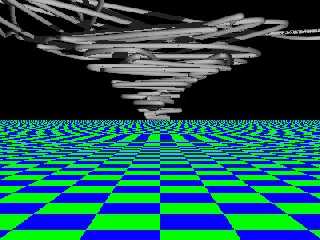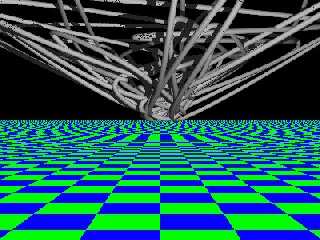|
 |
Bill DeWitt wrote:
> It probably really is, but to get to the bottom in the diminishing space
> available, while still varying in xy, it can't look like it is very much.
> You may need more z in your randomness rather than more randomness in your
> z.
Er...huh? The Z isn't random. How do I know?
observe figure 1, which uses following:
sphere_sweep{
#declare points=100;
cubic_spline points,
#declare Seed=seed(10000);
#declare N=1;
#while(N<=points)
#declare Theta=rand(Seed)*360;
#declare Z=(N/100)+1.2;
#declare R=(rand(Seed)*0.25)+((Z-1.2)*(Z-1.2)*2);
#declare X=R*cos(Theta);
#declare Y=R*sin(Theta);
<X, Y, Z> 0.02
#declare N=N+1;
#end
texture{ pigment{ color rgb <1.0, 1.0, 1.0> } }
}
observe figure 2, which uses following:
sphere_sweep{
#declare points=100;
cubic_spline points,
#declare Seed=seed(10000);
#declare N=1;
#while(N<=points)
#declare Theta=rand(Seed)*360;
#declare Z=rand(Seed)+1.2;
#declare R=(rand(Seed)*0.25)+((Z-1.2)*(Z-1.2)*2);
#declare X=R*cos(Theta);
#declare Y=R*sin(Theta);
<X, Y, Z> 0.02
#declare N=N+1;
#end
texture{ pigment{ color rgb <1.0, 1.0, 1.0> } }
}
I want the jumbled-upness of figure 2 in the shape of
figure 1. figure 2 has the random points, but they're
selected in such a way that parts of the sphere_sweep
are drawin outside the curve.
--
Tim Cook
http://empyrean.scifi-fantasy.com
mirror: http://personal.lig.bellsouth.net/lig/z/9/z993126
-----BEGIN GEEK CODE BLOCK-----
Version: 3.12
GFA dpu- s: a?-- C++(++++) U P? L E--- W++(+++)>$
N++ o? K- w(+) O? M-(--) V? PS+(+++) PE(--) Y(--)
PGP-(--) t* 5++>+++++ X+ R* tv+ b++(+++) DI
D++(---) G(++) e*>++ h+ !r--- !y--
------END GEEK CODE BLOCK------
Post a reply to this message
Attachments:
Download 'junk3.jpg' (43 KB)
Download 'junk4.jpg' (50 KB)
Preview of image 'junk3.jpg'

Preview of image 'junk4.jpg'

|
 |




![]()